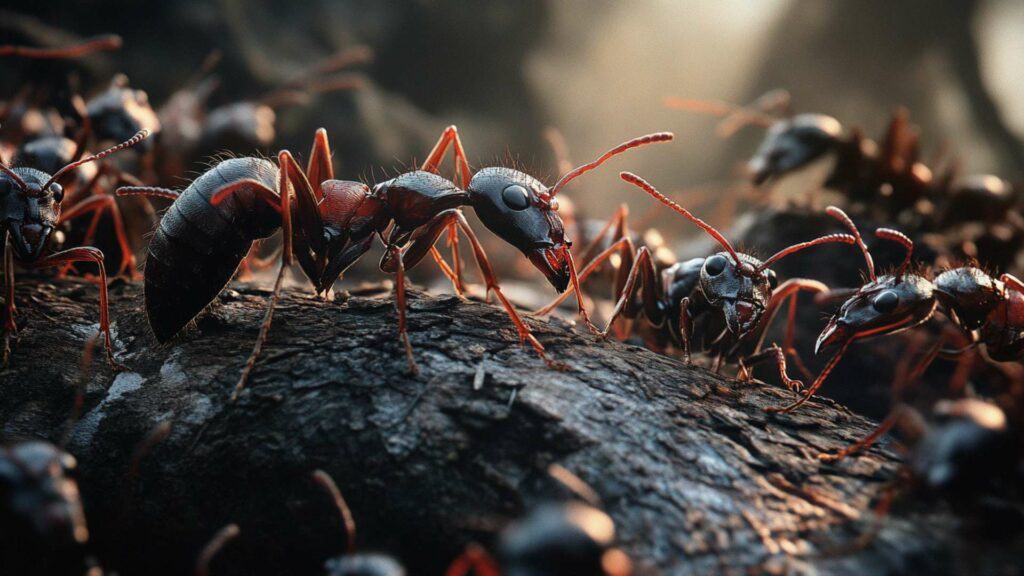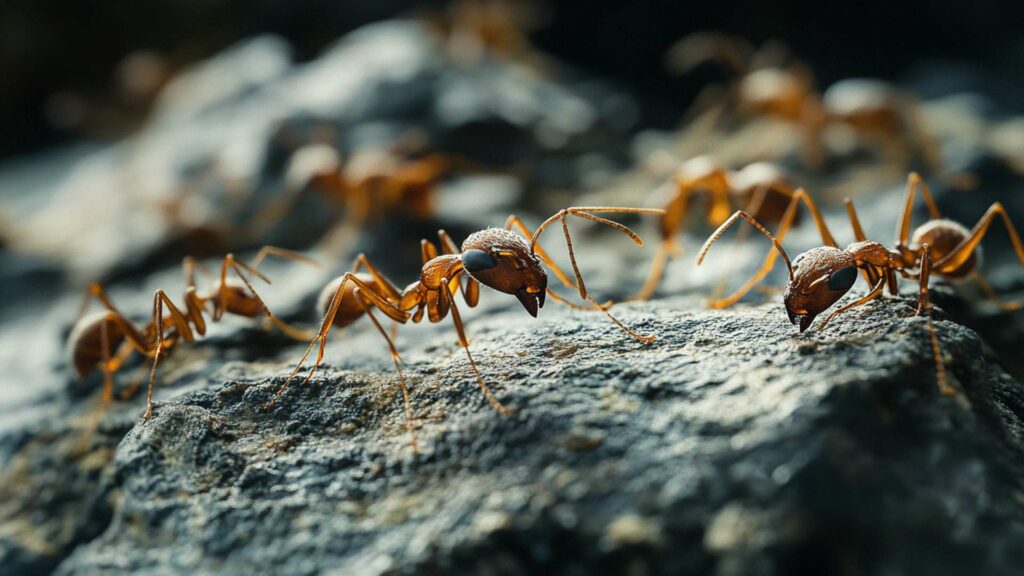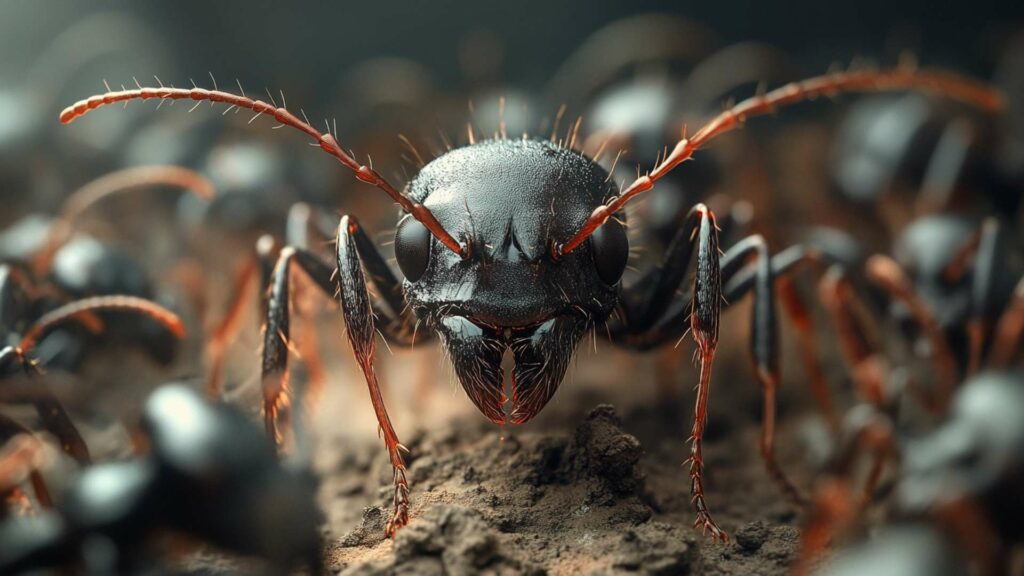Ants, those tiny creatures that scurry around our gardens and picnic spots, have an intricate lifestyle that goes beyond their busy search for food and relentless work ethic. Understanding their behavior throughout the year is key to comprehending what happens when winter arrives.
Like many other species, ants experience distinct changes in their routines as temperature drops and nature transitions into colder months. From foraging tirelessly during warm months to seeking shelter and conserving energy during autumn and winter, ants are truly fascinating creatures with a complex social structure.
When winter sets in, most ants face new challenges that drastically alter their daily routines. The warmer months are characterized by intense ant activity – gathering food, expanding the colony, and managing territories.
However, as temperatures begin to plummet, ants must adapt to survive. Their once bustling foraging trips become limited, nest locations change, and they prepare to endure the cold season with remarkable strategies.
So what do ants do in the winter? Let’s delve into the intriguing world of ant behavior during this colder period and explore how these resilient insects manage to cope with the challenges that winter presents them with.
Preparing for Winter

As the days grow shorter and colder, ants begin their preparations for the long winter ahead. These industrious insects understand the importance of securing enough food to sustain their colonies during this period of scarcity. To gather food reserves, ants employ various foraging strategies and exhibit distinct preferences based on their own ant species and specific needs.
Some ant species prefer sweet food sources like sugary nectar or honeydew secreted by aphids, while others are more inclined towards protein-rich options such as dead insects, eggs or seeds. These resourceful critters explore every nook and cranny in search of abundant food sources that will keep them nourished through the cold months.
Once ants have successfully collected sufficient amounts of sustenance, they carefully transport it back to their nests – a remarkable feat considering their tiny size. Ants have an innate ability to navigate their way back home using pheromone trails, visual cues, and even celestial landmarks. Once inside the nest, they store their precious finds in underground chambers or specialized storage areas within tree bark or other suitable materials near the surface.
This strategic storing helps ensure that adequate provisions are available throughout the winter when venturing outside becomes riskier due to harsh weather conditions and reduced opportunities for foraging. Preparing for winter is a critical phase in an ant’s life cycle as it ensures survival during times of scarcity.
Gathering abundant food reserves through various foraging strategies allows them to sustain themselves and their colonies throughout this challenging season. The meticulous storing of these provisions inside underground chambers or nests provides easy access while keeping them safe from predators and maintaining optimal conditions for survival until warmer days return.
Hibernation and Slowing Down
During the chilly winter months, ants engage in a remarkable survival strategy known as hibernation. Just like bears cozying up in their caves, ants retreat to their nests underground or seek shelter in other well-insulated hiding spots.
This behavior allows them to protect themselves from the harsh elements that winter brings. Hibernation is crucial for ants as it helps them conserve energy and resources, ensuring their survival until the warmer days of spring arrive.
Decreased metabolic rate and activity levels
To survive the winter with limited resources, ants adopt a clever approach: they significantly slow down their metabolic rate and minimize their overall activity levels. This means that most ants within colonies reduce or even halt all non-essential activities like foraging or scouting for new territories. By decreasing their energy expenditure during this period, they can make do with the stored reserves they accumulated during more abundant times.
Conservation of energy and resources
The conservation of energy becomes paramount for ants during winter. With fewer available food sources due to the scarcity of plant matter, insects, and other creatures that attract ants during warmer periods, ants rely on what they have stored within their nests to sustain themselves until spring arrives. By conserving resources through decreased activity levels and lowered metabolic rates, ants ensure they have enough provisions to survive the winter months without venturing outside unnecessarily to eat more.
In essence, hibernation allows these industrious creatures to adapt to harsh weather conditions by reducing their body temperatures and entering into a state of dormancy. Through this strategic slowdown in activity, carpenter ants or any other species can patiently wait out the cold season safely tucked away in the warmth of their nests beneath tree bark or underground burrows.
Nesting Behavior in Winter

During the chilly winter months, ants employ various strategies to ensure their survival. One crucial aspect of their winter behavior is finding suitable nest locations that provide protection from the harsh elements.
Most ants seek shelter underground, utilizing the depth and insulation of the soil to maintain stable body temperatures indoors. This allows them to survive even when temperatures drop significantly above ground.
Some ant species, however, opt for alternative nesting sites such as leaf litter or tree trunks, which can also provide insulation against the cold. By seeking refuge in these hidden spots, ants can safeguard themselves against extreme weather conditions and hostile predators.
Ants are resourceful creatures when it comes to finding shelter during winter. Many species choose to construct their nests underground, excavating intricate tunnels and chambers that act as cozy hideaways from freezing temperatures. These ant nests are meticulously designed to regulate temperature and humidity levels, creating a comfortable environment for the house and colony’s inhabitants.
By building their nests beneath the earth’s surface, ants gain protection not only from the biting cold but also from potential predators lurking above ground. Some ant species exhibit a preference for nesting within leaf litter or even hollowed-out tree trunks.
These natural niches offer insulation against frost and wind while providing an additional layer of protection against predators like birds or other insects seeking an easy meal. By adapting their nesting behavior to capitalize on these alternative habitats during winter months, ants demonstrate their remarkable ability to survive in diverse environments.
Utilizing existing underground tunnels or creating new ones
When it comes to selecting a suitable location for winter nesting, some ant colonies repurpose existing underground tunnels instead of constructing new ones from scratch. This approach helps conserve energy while still ensuring survival throughout the colder months.
By repurposing and expanding pre-existing tunnels, ants can establish a network of interconnected chambers that provide ample space for the colony to thrive. This also allows them to tap into resources that may have been previously stored within these tunnels, ensuring a stable supply of food during the scarcity of winter.
Alternatively, certain ant species exhibit remarkable adaptability by creating new underground tunnels specifically for winter nesting. These industrious creatures dig tirelessly, constructing intricate systems of chambers and passageways, all with the aim of securing a comfortable haven for their colony.
By actively building and expanding their nests, ants can better regulate temperature, humidity levels, and access to food sources. This ability to construct new habitats reflects the remarkable adaptability and resilience displayed by ants in coping with changing seasons.
Ants strategically choose nest locations during winter based on their survival needs. Whether underground in soil or utilizing leaf litter and tree trunks as shelter alternatives, these resourceful creatures ensure their colonies’ survival through ingenious adaptations to secure warm havens amidst freezing temperatures.
Maintaining Nest Temperature

Ants, just like us humans, prefer to stay cozy in the winter months. To combat the temperature drops, these tiny creatures have developed some impressive thermoregulation strategies.
They possess a remarkable ability to regulate their body heat collectively to keep their nests warm. By clustering together, ants generate heat through metabolic processes and create a toasty microclimate within their underground abodes.
Imagine a bustling metropolis within an ant hill in the cold winter months. Each ant plays a crucial role in maintaining the temperature balance within the ant colony.
They cluster together, forming a tight-knit mass that traps heat generated by their own bodies. This collective warmth helps them survive even warm months when the outside world is freezing.
As resourceful creatures, ants don’t stop at utilizing collective body heat alone. They are keen on finding warmer microclimates within their nests as well. Some species of ants construct elaborate systems of tunnels that direct warm air from above-ground sources like tree bark or house heating vents into their chambers deep underground.
This architectural marvel not only provides insulation but also ensures that each chamber maintains an ideal temperature for different activities. So, next time you spot an ant hill during winter, remember that beneath the chilly ground lies a bustling community of industrious insects employing fascinating techniques to keep themselves cozy and thriving despite external challenges.
Limited Foraging Activities
During the winter months, ants face a significant challenge in finding food. The cold weather suppresses the growth of plants and reduces the availability of insects and other small creatures that ants typically rely on for sustenance.
This scarcity find food means that there is simply less food to be found outside the nest. As a result, ants reduce their foraging trips as they struggle to locate adequate food sources.
To overcome this scarcity, ants wisely prepare in advance by gathering and storing food reserves during the warmer months. They diligently collect seeds, fruits, dead insects, and other organic matter to ensure they have enough supplies to sustain them through winter. These stored reserves become a crucial lifeline attracts ants during this period when venturing outside becomes more challenging due to the cold temperatures.
To conserve energy and avoid unnecessary exposure to freezing temperatures, ants minimize their trips outside as much as possible during winter. Instead of actively foraging like they do in warmer months, they rely on their stored provisions within the safety and relative warmth of their nests.
By staying indoors and reducing activity levels, ants can preserve body heat and energy resources necessary for survival in winter. Limited foraging activities among ants during winter are a direct consequence of scarce food sources.
Ants wisely rely on their previously collected stores instead of actively seeking out new sources from their surroundings. By conserving energy through careful reduction in outdoor ventures, ants prioritize survival during these challenging colder months when nature’s bounty becomes scarce.
Protection Against Predators and Parasites

During the winter months, when temperatures drop and ant activity slows down due to their slower metabolic state, ants employ various strategies to protect their nests from predators and parasites. One of the primary tactics is closing off entrances with debris or temporarily sealing them.
This serves as a barricade against unwanted intruders such as other insects or small mammals that may seek refuge indoors in ant nests. By blocking entry points, ants ensure the safety of ants inside their colonies and prevent potential harm.
To close off entrances, worker ants actively collect small pieces of debris like twigs, leaves, and soil particles. They use these materials to plug or obstruct any openings that may provide access into the nest.
By doing so, they create a physical barrier that prevents predators from infiltrating their cozy abode. These closed-off entrances also help maintain stable temperature conditions within the nest by reducing heat loss during colder periods.
In addition to closing off entrances with debris, ants increase guard presence at the nest entrance during winter months. Worker ants take turns monitoring the surroundings and defending ant nest against potential threats.
This increased vigilance helps ensure that only authorized individuals are granted access inside while deterring any potential predators or parasites from getting too close. The guards utilize their keen senses and communicate danger signals to alert others of impending risks.
By employing these defensive strategies, ants are able to protect their colonies effectively during winter’s challenging conditions when resources are scarce and temperatures are harsh. These remarkable creatures demonstrate remarkable adaptability and teamwork in order to survive the winter season intact.
Interactions within the Colony
During the winter months, when temperatures drop and food becomes scarce, ants rely heavily on their social interactions to maintain colony cohesion. These tiny creatures understand the importance of sticking together to survive the harsh conditions. They communicate with each other using pheromones and touch, constantly reinforcing their bond.
Ants engage in grooming behaviors, meticulously cleaning themselves and their comrades to remove parasites and maintain hygiene within the colony. This communal activity helps prevent diseases from spreading among the ants, ensuring their survival throughout winter.
Contact is vital for maintaining harmony within an ant colony during winter. Ants are known to engage in a behavior called “trophallaxis,” where they share food by regurgitating it from one ant’s mouth to another’s.
This phenomenon not only helps distribute nutrients throughout the colony but also strengthens social ties, reinforcing cooperation and unity among individual ants. Additionally, ants use touch as a means of communication, frequently tapping or antennating each other to convey information about food sources or potential threats.
Conclusion
In plain sight beneath our feet lies a bustling world of resilience and perseverance – the world of ants in winter. As soil covers their nests and ant hills become less prominent during colder months, these incredible creatures adapt by entering a slower metabolic state while continuing essential activities for survival. Seeking shelter underground or in tree trunks protects them from freezing temperatures while maintaining nest temperature through collective body heat ensures a suitable habitat for eggs and larvae.
Although foraging activities may be limited due to scarcity of food sources, social interactions within ant colonies can play a critical role in maintaining cohesion and supporting one another until spring arrives with its renewed abundance. Just as ants persevere through winter’s challenges together, we too can find inspiration in their unwavering resilience and the power of unity.
Deter Ants with D-Termination: Las Vegas’ Leading Pest Control Solution!

If you’re grappling with ant problems, D-Termination is your go-to. Our proficient team excels at discouraging ants, rejuvenating cleanliness, and preserving the integrity of your surroundings. Bid farewell to ants—opt for D-Termination for effective pest control today!
Get in touch with us at 702-919-6310 or visit dtermination.com to schedule your ant control service and regain your space from these unwanted pests.
Frequently Asked Questions:
Ants often become less active in winter but don’t entirely disappear.
Ants survive winter by entering a state of dormancy in their nests.
Ant activity tends to decrease in colder months, typically from late autumn to early spring.
Cold weather can slow down ant activity, but it usually doesn’t kill them unless it’s extremely harsh.







